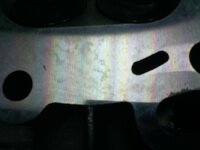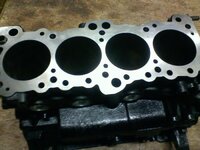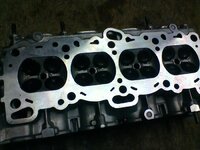EagleTalonTim
15+ Year Contributor
- 833
- 13
- Jan 10, 2007
-
Brighton,
Tennessee
Hello all once again! I am in the middle of a full rebuild and decided to try to go with an MLS head gasket again. The last one did not seal since I did not have the block machined. I called many companies around my area to ensure the one I chose used a mill machine and not a sander. Only one is in my area  I spent $300 having the block dipped, head and block resurfaced, install my supertech valves and springs, and install new valve stem seals. The owner ensured me he had been doing this kind of work for over 30 years, but I am not sure if it was done right. On both the block and head surface, I can feel and see mill lines. Like little ribs all the way down the surfaces. They are very small and I am sure an OEM gasket would seal, but I am wanting to go MLS for higher pressures and my 500 HP goal. Are the small ribs going to be a problem? If needed, I can try to post a picture.
I spent $300 having the block dipped, head and block resurfaced, install my supertech valves and springs, and install new valve stem seals. The owner ensured me he had been doing this kind of work for over 30 years, but I am not sure if it was done right. On both the block and head surface, I can feel and see mill lines. Like little ribs all the way down the surfaces. They are very small and I am sure an OEM gasket would seal, but I am wanting to go MLS for higher pressures and my 500 HP goal. Are the small ribs going to be a problem? If needed, I can try to post a picture.
 I spent $300 having the block dipped, head and block resurfaced, install my supertech valves and springs, and install new valve stem seals. The owner ensured me he had been doing this kind of work for over 30 years, but I am not sure if it was done right. On both the block and head surface, I can feel and see mill lines. Like little ribs all the way down the surfaces. They are very small and I am sure an OEM gasket would seal, but I am wanting to go MLS for higher pressures and my 500 HP goal. Are the small ribs going to be a problem? If needed, I can try to post a picture.
I spent $300 having the block dipped, head and block resurfaced, install my supertech valves and springs, and install new valve stem seals. The owner ensured me he had been doing this kind of work for over 30 years, but I am not sure if it was done right. On both the block and head surface, I can feel and see mill lines. Like little ribs all the way down the surfaces. They are very small and I am sure an OEM gasket would seal, but I am wanting to go MLS for higher pressures and my 500 HP goal. Are the small ribs going to be a problem? If needed, I can try to post a picture.



















